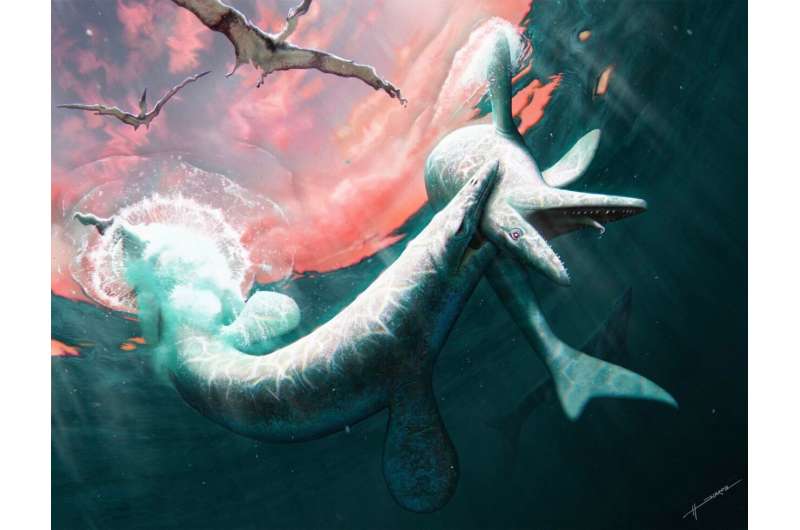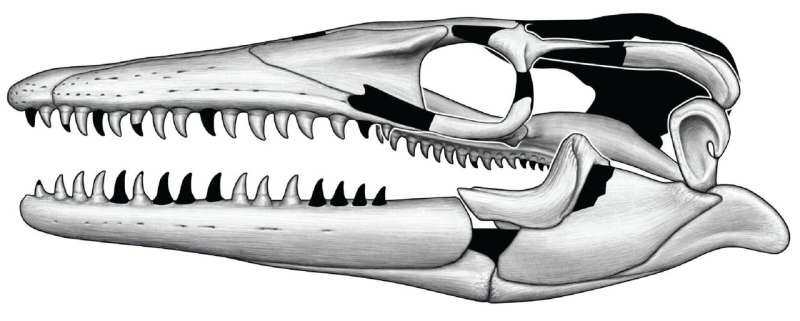This article has been reviewed according to Science X's editorial process and policies. Editors have highlighted the following attributes while ensuring the content's credibility:
fact-checked
trusted source
proofread
New species of mosasaur named for Norse sea serpent

Scientists have discovered a new species of mosasaur, large, carnivorous aquatic lizards that lived during the late Cretaceous. With "transitional" traits that place it between two well-known mosasaurs, the new species is named after a sea serpent in Norse mythology, Jormungandr, and the small North Dakota city Walhalla near to where the fossil was found.
Details describing Jǫrmungandr walhallaensis are published today in the Bulletin of the American Museum of Natural History.
"If you put flippers on a Komodo dragon and made it really big, that's basically what it would have looked like," said the study's lead author Amelia Zietlow, a Ph.D. student in comparative biology at the American Museum of Natural History's Richard Gilder Graduate School.
The first mosasaur was discovered more than 200 years ago, and the word "mosasaur" predates the word "dinosaur." But many questions about these animals remain, including how many times they evolved flippers and became fully aquatic—researchers think it was at least three times, and maybe four or more—and whether they are more closely related to monitor lizards or snakes. Researchers are still trying to determine how the different groups of mosasaurs are related to each other, and the new study adds a new piece to that puzzle.
The fossil on which the study is based was discovered in 2015, when researchers excavating in the northeastern part of North Dakota found an impressive specimen: a nearly complete skull, jaws, and cervical spine, as well as a number of vertebrae.

After extensive analysis and surface scanning of the fossil material, Zietlow and her collaborators found that this animal is a new species with a mosaic of features seen in two iconic mosasaurs: Clidastes, a smaller and more primitive form of mosasaur; and Mosasaurus, a larger form that grew to be nearly 50 feet long and lived alongside Tyrannosaurus rex.
The specimen is estimated to be about 24 feet long, and in addition to flippers and a shark-like tail, it would have had "angry eyebrows" caused by a bony ridge on the skull, and a slightly stumpy tail that would have been shorter than its body.
"As these animals evolved into these giant sea monsters, they were constantly making changes," Zietlow said. "This work gets us one step closer to understanding how all these different forms are related to one another."
The work suggests that Jormungandr was a precursor to Mosasaurus and that it would have lived about 80 million years ago.
"This fossil is coming from a geologic time in the United States that we don't really understand," said co-author Clint Boyd, from the North Dakota Geological Survey. "The more we can fill in the geographic and temporal timeline, the better we can understand these creatures."
Coauthor Nathan Van Vranken from Eastern West Virginia Community and Technical College added, "The tale of Jormungandr paints a wonderful picture and helps contribute to our understanding of the northernmost regions of the interior seaway, especially with the mosasaurs, and discoveries such as these can pique scientific curiosity."
More information: Zietlow, Amelia R. et al, Jormungandr walhallaensis : a new mosasaurine (Squamata: Mosasauroidea) from the Pierre Shale Formation (Pembina Member: Middle Campanian) of North Dakota, Bulletin of the American Museum of Natural History (2023). digitallibrary.amnh.org/items/ … f9-8d1d-0d4ab6aaedfb
Provided by American Museum of Natural History





















